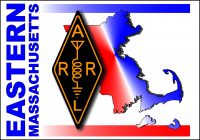Hello to all….
Heavey Hitters Traffic Net Manager, Byron Piette-K1YCQ, will be sponsoring a special edition of the Heavy Hitters Traffic Net to allow clubs and Field Day groups to bring NTS traffic related to Field Day to the net for points on Field Day. Below is information on the net.
Here is the info about the Field Day Net.
Heavy Hitters Traffic Net is sponsoring a Special Events Fielday Traffic Net on 6/28/08 @ 10 pm. on the MMRA and linked System. The purpose of this net is to allow clubs to bring their Fielday generated Traffic for Points to the net .Clubs can earn 100 points for sending an appropriate message to the Section Mgr. and also may receive 10 points for each additional message Originated ,Received,Sent,or Relayed OR ANY combination thereof,up to a Maxium of 10messages.
Messages MUST be in NTS format ONLY Brief and to the point ,ONLY Fielday /Point traffic is allowed on this special net Clubs /Stations are advised to check Frequencies to be used on the MMRA linked system at
http://www.mmra.org
Please have on hand a sufficient supply of ARRL “RADIOGRAM” forms. This will help you a lot.
They may be copied at http://www.ema.arrl.org
WE wish to thank MMRA and its Officers for the use of their great system (they are a super group. WE thank also the operators of the “linked systems” to the mmra
Please join us on our regular nets Mon.-Fri. at 10 pm. Traffic/Rag chew if time permits.
J,Byron Piette
HHTN Net Mgr.
—
Respectfully Submitted,
Robert Macedo (KD1CY)
ARES SKYWARN Coordinator
Eastern Massachusetts ARES Section Emergency Coordinator
Pager #: (508) 354-3142
Home Phone #: (508) 994-1875 (After 6 PM)
Home/Data #: (508) 997-4503 (After 6 PM)
Work Phone #: 1-800-445-2588 Ext.: 72929 (8 AM-5 PM)
Email Address: rmacedo@rcn.com
http://ares.ema.arrl.org
http://www.wx1box.org
1


 The November, 2008 EMA Station Activity Report and Public Service Honor Roll totals have been posted to nts.ema.arrl.org under
The November, 2008 EMA Station Activity Report and Public Service Honor Roll totals have been posted to nts.ema.arrl.org under  The October, 2008 EMA traffic net and Public Service Honor Roll totals have been posted to
The October, 2008 EMA traffic net and Public Service Honor Roll totals have been posted to  The annual Traffic Handlers Picnic for Eastern Massachusetts will be held Sunday, August 3, 2008 at the Raynham Senior Citizen Center picnic area in Raynham, MA. The picnic will run from 12:00 p.m. to 4:00 p.m. [
The annual Traffic Handlers Picnic for Eastern Massachusetts will be held Sunday, August 3, 2008 at the Raynham Senior Citizen Center picnic area in Raynham, MA. The picnic will run from 12:00 p.m. to 4:00 p.m. [
 Mike Wilbur, N2JWW writes:
Mike Wilbur, N2JWW writes: The Heavy Hitters Traffic Net, one of the primary VHF FM local NTS nets in Eastern MA will run on a special field day schedule, according to John Miller, N1UMJ.
The Heavy Hitters Traffic Net, one of the primary VHF FM local NTS nets in Eastern MA will run on a special field day schedule, according to John Miller, N1UMJ. The March, 2008 EMA traffic net and Public Service Honor Roll totals have been posted to
The March, 2008 EMA traffic net and Public Service Honor Roll totals have been posted to